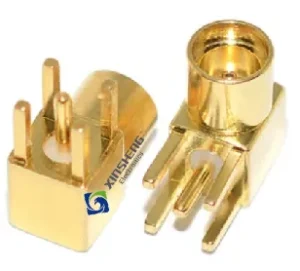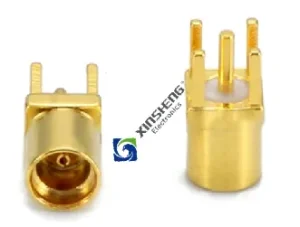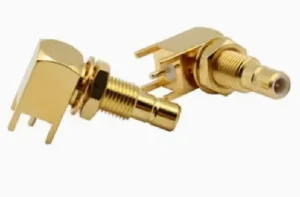Introducing Sub-Miniature RF Connectors
Introduction
In an era where electronic devices are shrinking while performance demands are skyrocketing, the need for high-frequency, space-saving connectivity solutions has never been greater. Sub-Miniature RF connectors have emerged as critical components in industries ranging from telecommunications to aerospace, medical devices, automotive electronics, and military applications. These compact yet powerful connectors enable high-speed data transmission, reliable signal integrity, and robust performance in even the most constrained environments.
This comprehensive guide will explore:
- What Sub-Miniature RF connectors are and how they work
- Different types and their unique advantages
- Key benefits over traditional RF connectors
- Major industry applications
- How to choose the right connector for your needs
- Future trends in RF connector technology
By the end of this blog, you’ll have a deep understanding of why these connectors are indispensable in modern electronics and how they are shaping the future of wireless communication.
Additional Historical Context and Evolution
The origin of sub-miniature RF connectors dates back to the rapid technological evolution in the mid-20th century, when engineers began demanding more compact components without compromising performance. Traditional connectors like the BNC and N-type became too bulky for evolving applications, especially in the aerospace and military sectors where both size and weight had to be minimized. This led to the creation of the SMA connector, followed by others like SMB, SMC, MCX, and MMCX. Each new generation of connectors became progressively smaller and more specialized, enabling faster and more efficient data transmission while taking up significantly less space.
Over the years, innovations in materials science and manufacturing precision allowed these connectors to support higher frequencies, reduced insertion loss, and better environmental resistance. As more industries adopted wireless technologies, the relevance of sub-miniature RF connectors expanded exponentially. Today, they play a crucial role in everything from consumer electronics and telecommunications to life-saving medical equipment and cutting-edge aerospace systems.
Design Considerations and Customization Options
Engineers working with sub-miniature RF connectors must consider more than just size and frequency. Key design considerations include:
- Material Selection: High-quality connectors often use brass, stainless steel, or beryllium copper for conductivity and durability. Platings like gold or nickel improve corrosion resistance and ensure long-term reliability.
- VSWR and Insertion Loss: For high-speed communication systems, it’s critical to select connectors with a low Voltage Standing Wave Ratio (VSWR) and minimal insertion loss. This ensures that the signal remains strong and clear.
- Shielding Effectiveness: EMI shielding is essential, especially in dense electronic environments. Some sub-miniature connectors are designed with multiple layers of shielding or internal grounding features.
- Waterproofing and IP Ratings: In outdoor or rugged environments, connectors with IP67 or IP68 ratings can protect sensitive signals against water and dust ingress.
- Customization Options: Many manufacturers, including Xinsheng Electronics, offer customization services to match exact performance criteria—such as specific cable lengths, plating options, and unique mating interfaces—to optimize the connector for your specific device.
These design elements ensure that the final connector solution is not only functional but also optimal in terms of performance, cost, and reliability. A well-selected and properly integrated RF connector can be the difference between a device that functions flawlessly and one that fails under real-world conditions.


Key Applications Across Emerging Technologies
As technology advances, sub-miniature RF connectors are finding their way into new and emerging markets. One prominent area is augmented and virtual reality (AR/VR). Devices like VR headsets demand compact and high-bandwidth connectivity, making MCX and MMCX connectors essential in headset design for their size and signal performance.
Smart agriculture is another field benefiting from miniaturized RF components. Sensors distributed across farmland transmit environmental data using RF communication, often depending on low-profile, rugged connectors to withstand exposure to water, soil, and varying temperatures.
In unmanned aerial vehicles (UAVs) and drones, weight and space constraints are extreme. Sub-miniature connectors provide reliable data and control signal pathways without compromising flight efficiency. Their vibration resistance also makes them ideal for drones used in industrial inspections, cinematography, and emergency response.
In the wearable tech sector, fitness trackers and smartwatches rely on compact, lightweight connectors that can handle constant movement and moisture exposure. RF connectors in these devices enable Bluetooth, Wi-Fi, and GPS functions while maintaining a sleek form factor.
Additionally, the space exploration sector increasingly utilizes CubeSats and small satellite platforms. These devices need lightweight components that can survive extreme conditions, making sub-miniature RF connectors indispensable. They ensure critical data transmission between subsystems like antennas, onboard computers, and power distribution units.
Advantages Over Traditional Connectors
Sub-miniature RF connectors have several key advantages over their traditional counterparts:
- Compact Size: Their reduced form factor is essential for portable and embedded systems.
- Improved Frequency Response: Many sub-miniature connectors can support signals up to 40 GHz or beyond.
- Quick Mating Options: Snap-on and push-pull mechanisms reduce assembly time.
- Lower Weight: Especially important in aerospace and wearable tech.
- Greater Integration: Allows for denser circuit board layouts and modular design approaches.
These features collectively enable innovation in product development, where every millimeter and microsecond count.
Installation and Maintenance Tips
Installing sub-miniature RF connectors properly is crucial to ensure performance and longevity:
- Use Proper Torque Tools: Over-tightening or under-tightening threaded connectors can cause signal degradation.
- Inspect Before Use: Check for bent pins, dust, or debris before mating.
- Follow Cable Bend Radius Guidelines: Avoid sharp bends that could damage internal conductors.
- Use Matching Pairs: Ensure connectors are properly paired in terms of impedance and type.
- Perform Periodic Checks: Especially in mission-critical applications, schedule regular inspections and tests.
Following these practices can significantly extend the lifespan of your connectors and ensure consistent system performance.

Emerging Standards and Testing Protocols
As RF communication evolves, so do the standards governing component performance. Regulatory bodies such as the International Electrotechnical Commission (IEC) and the Institute of Electrical and Electronics Engineers (IEEE) are establishing benchmarks for sub-miniature RF connectors.
Advanced testing tools are now used to assess:
- Return loss and insertion loss across multiple frequency bands
- Resistance to electromagnetic interference (EMI)
- Thermal cycling and temperature stability
- Mating cycle endurance for long-term usability
Manufacturers are also investing in in-house quality control laboratories. Automated inspection tools and 3D imaging now help catch flaws during production, ensuring that every connector meets required specifications before shipment.
For designers and engineers, selecting components certified under these protocols reduces the risk of system failure, improves compliance with international trade regulations, and boosts customer trust.
Environmental Sustainability and Future Developments
Modern industries are increasingly focused on sustainability, and RF connector technology is no exception. Sub-miniature connectors are now being developed with recyclable materials, energy-efficient production processes, and longer life cycles to reduce electronic waste. Innovations in connector design also allow for modular replacements instead of full system overhauls, further minimizing environmental impact.
- In the near future, we can expect the following trends:
- Eco-friendly Manufacturing: Companies are adopting green practices and environmentally safe coatings.
- Smart Connectors: Built-in diagnostics to monitor signal quality and detect degradation.
- Additive Manufacturing: 3D printing for custom, small-batch RF connectors, reducing waste and production lead time.
- Nano-Connectors: For ultra-small devices like biomedical implants, next-gen RF connectors may approach molecular scales.
The integration of these technologies will not only improve performance but also align the electronics industry with global sustainability goals.
Choosing the Right Partner for Sub-Miniature RF Solutions
Selecting the appropriate sub-miniature RF connector is crucial—but equally important is choosing the right partner to supply and support that connector. An experienced and reliable supplier can be a game-changer in terms of product longevity, quality assurance, and overall system performance.
Look for manufacturers that provide:
- Comprehensive Technical Support: From design consultation to after-sales troubleshooting, having knowledgeable engineers on hand can prevent delays and design errors.
- Certifications and Compliance: Ensure the supplier complies with global standards such as RoHS, ISO, and REACH. This guarantees quality, safety, and environmental compatibility.
- Customization Capabilities: Not every project is standard. Whether it’s a unique cable length or a modified housing, a partner that can quickly adapt to custom requirements is invaluable.
- Global Distribution Network: Timely delivery is essential for keeping development and production on track. Working with a supplier that has a broad distribution footprint minimizes delays.
- Field-Proven Reliability: Case studies, client testimonials, and real-world usage examples provide reassurance that the connectors will perform as expected in demanding environments.
Xinsheng Electronics stands out in these areas by combining deep industry expertise with responsive customer service. With decades of experience and an ever-growing product portfolio, we help clients across telecom, medical, aerospace, defense, and consumer electronics sectors bring their ideas to life.
If you’re aiming to build cutting-edge systems with optimal performance and long-term reliability, choosing Xinsheng Electronics as your connector partner ensures a streamlined, efficient, and success-oriented process.
Sub-miniature RF connectors are enabling a new era of miniaturized, high-performance, and multifunctional electronic systems. As wireless demands evolve and devices shrink, these compact solutions are becoming foundational in the next generation of RF and microwave technologies.
Whether you’re building a satellite payload, a 5G antenna, a wearable heart monitor, or a next-gen autonomous vehicle, selecting the right sub-miniature connector is key to achieving both performance and reliability.
At Xinsheng Electronics, we provide a comprehensive range of high-performance sub-miniature RF connectors including SMA, SMB, SMC, MCX, and MMCX models. Our connectors meet industry standards and are trusted by telecom, aerospace, medical, and automotive leaders worldwide.
Let us help you optimize your RF design—contact us today for samples, customization, or technical consultation.



